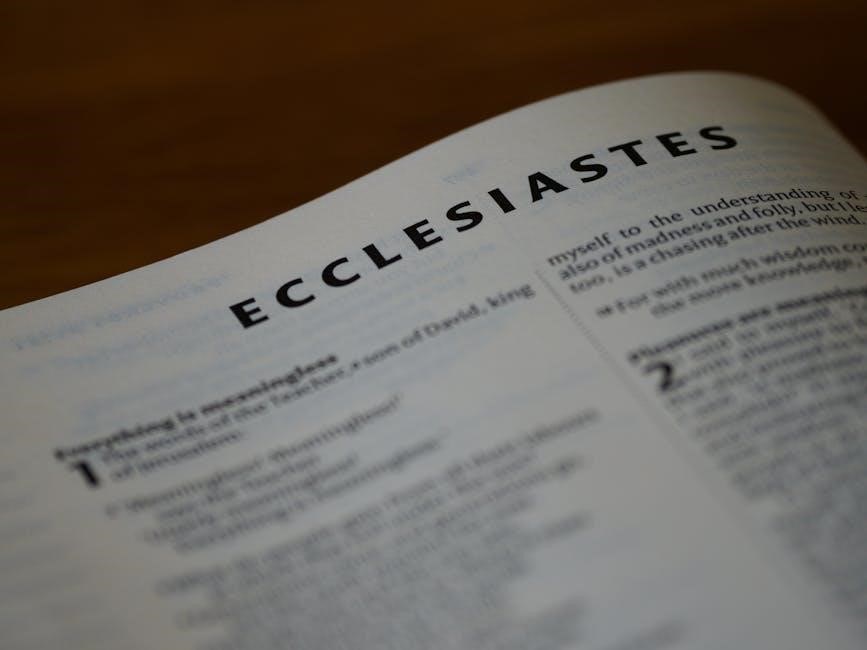Bible reading plans offer structured approaches to exploring Scripture, often dividing readings between the Old and New Testaments. These plans provide daily or weekly schedules, ensuring a balanced understanding of God’s Word. Available in PDF formats, they cater to various preferences, helping readers stay consistent and deepen their spiritual journey.
Overview of the Old and New Testaments
The Bible is divided into two main sections: the Old Testament and the New Testament. The Old Testament contains 39 books, chronicling God’s relationship with His people, including creation, laws, history, poetry, and prophecy; The New Testament comprises 27 books, focusing on the life, teachings, death, and resurrection of Jesus Christ, as well as the early Christian church. Together, they reveal God’s plan of salvation and provide spiritual guidance. Reading plans often balance passages from both testaments, helping readers understand their interconnectedness and profound theological themes.

Importance of Structured Reading Plans
Structured Bible reading plans are essential for fostering consistency and depth in Scripture study. They provide a clear framework, helping readers navigate the Bible systematically. By assigning specific passages for each day or week, these plans prevent overwhelm and ensure progress. They also promote spiritual discipline, encouraging regular engagement with God’s Word. Moreover, structured plans often balance Old and New Testament readings, offering a holistic understanding of biblical themes. This intentional approach helps readers avoid skipping complex sections and ensures they encounter the full narrative of God’s redemption story. Ultimately, structured plans support spiritual growth and a deeper connection with Scripture.
Benefits of Reading Both Testaments
Reading both the Old and New Testaments provides a comprehensive understanding of God’s plan. The Old Testament establishes the historical and cultural context, while the New Testament reveals the fulfillment of promises through Jesus Christ. Together, they offer insights into God’s character, humanity’s condition, and the redemptive story. This balanced approach fosters a deeper appreciation of biblical themes, such as covenant, grace, and redemption. It also enriches personal devotion, as readers see how Old Testament prophecies and principles are fulfilled in the New Testament. By engaging both Testaments, believers gain a unified view of Scripture, enhancing their spiritual growth and discipleship journey.

Structure of a Comprehensive Bible Reading Plan

A comprehensive Bible reading plan typically includes daily readings from the Old Testament, New Testament, Psalms, and Proverbs, ensuring a balanced and systematic study of Scripture.
Breaking Down the Old Testament
The Old Testament is divided into 39 books, offering a rich narrative of God’s relationship with His people. Reading plans often break it into historical books (Genesis–Esther), wisdom literature (Job–Song of Solomon), and prophetic writings (Isaiah–Malachi). Many plans allocate specific days or sections to each category, ensuring a systematic study. For example, a one-year plan might assign two chapters daily from the Old Testament, alternating between historical and prophetic texts. This structure provides context and depth, helping readers understand the progression of God’s plan and its fulfillment in the New Testament. Incorporating Psalms and Proverbs adds spiritual reflection and practical wisdom.
Exploring the New Testament
The New Testament consists of 27 books, detailing the life of Christ, the early church, and letters to believers. Reading plans often organize it into the Gospels (Matthew–John), Acts, Epistles (Romans–Jude), and Revelation. Many plans balance daily readings by pairing a passage from the Gospels or Epistles with one from the Old Testament. This approach highlights connections between the testaments, showing how the Old Testament foreshadows the New. For instance, a one-year plan might dedicate two chapters daily to the New Testament, focusing on key teachings of Jesus and apostolic guidance. This structured exploration fosters a deeper understanding of the New Testament’s message of salvation and grace.
Incorporating Psalms and Proverbs
In many Bible reading plans, Psalms and Proverbs are included to provide spiritual guidance and wisdom alongside Old and New Testament readings. These books offer poetic reflections and practical insights, enriching the reading experience. Plans often alternate between Psalms and Proverbs, ensuring a balance of worship and wisdom. For example, a one-year plan might assign one Psalm and one Proverb daily, complementing the historical and doctrinal passages. This integration helps readers connect the emotional and practical aspects of faith with the broader narrative of Scripture, fostering a deeper and more holistic understanding of God’s Word throughout the year.

Types of Bible Reading Plans
Bible reading plans vary, including one-year, 90-day, and chronological options. They cater to different preferences, helping readers engage with Scripture consistently and effectively, suiting various goals and preferences;
One-Year Reading Plan
A one-year Bible reading plan is a popular choice for those seeking to read the entire Bible in 12 months. This structured approach typically includes daily readings from both the Old and New Testaments, ensuring a balanced understanding. Many plans also incorporate selections from Psalms and Proverbs to enrich spiritual growth. With approximately four chapters a day, readers can systematically progress through all 66 books. PDF versions of these plans are widely available, offering convenience for printing or digital use. This method helps maintain consistency and provides a comprehensive overview of Scripture, making it ideal for both new and experienced readers.
90-Day Reading Plan
A 90-day Bible reading plan is designed for those who want to cover the entire Bible in a shorter timeframe. This intensive schedule requires a significant daily commitment, typically around 30 minutes, to read through all 66 books. The plan is ideal for individuals seeking a fast-paced, cover-to-cover approach, ensuring exposure to both familiar and lesser-known passages. PDF versions of this plan are widely available, offering structured daily readings that progress through the Old and New Testaments. While it demands discipline, the 90-day plan provides a unique opportunity to experience the Bible’s overarching narrative and theological themes in a condensed period.

Chronological Reading Plan
A chronological Bible reading plan organizes Scripture in the order of historical events, allowing readers to follow the timeline of biblical history seamlessly. This approach begins with creation in Genesis and progresses through the Old Testament, transitioning into the life of Jesus, and concluding with Revelation. PDF versions of chronological plans are popular, as they provide clear daily readings that align with historical context. By reading in this order, readers gain a deeper understanding of how events unfold and connect across different books. This method is particularly useful for grasping the progression of God’s plan and the interconnectedness of the Old and New Testaments.
Book-by-Book Reading Plan
A book-by-book reading plan guides readers through the Bible by focusing on one book at a time, from Genesis to Revelation. PDF versions of this plan are widely available, offering structured schedules and checkpoints. This method allows for a deeper dive into each book’s themes, characters, and theological insights. By reading entire books without interruption, readers can better grasp the author’s intent and the flow of the narrative. This approach is ideal for those seeking a thorough understanding of individual books while maintaining a steady pace through the entire Bible over a set period, such as one year.

Benefits of a Structured Reading Schedule
A structured reading schedule fosters consistency, enhances understanding, and promotes spiritual growth by organizing daily devotion and ensuring steady progress through the Bible.
Spiritual Growth and Discipleship
A structured Bible reading plan is a powerful tool for spiritual growth and discipleship. By consistently engaging with Scripture, readers deepen their relationship with God and gain a stronger foundation for faith. Daily devotion helps build accountability, ensuring regular time with God’s Word. This routine fosters spiritual disciplines, such as prayer and reflection, which are essential for maturing in faith. Reading plans also encourage a systematic study of the Bible, revealing its transformative power. As believers apply biblical truths to their lives, they grow in obedience, wisdom, and Christ-like character. A structured plan supports intentional discipleship, helping believers become more like Jesus and live out their faith authentically.
Enhanced Understanding of Scripture
A structured Bible reading plan enhances understanding of Scripture by providing context and revealing connections between the Old and New Testaments. Daily readings guide believers through the Bible’s narrative, helping them grasp its overarching themes and theological depth. By following a plan, readers gain a clearer picture of God’s redemptive plan and the unity of His Word. This systematic approach prevents fragmented understanding, allowing readers to see how individual passages fit into the larger story. Additionally, plans often include Psalms and Proverbs, offering practical wisdom and spiritual reflection. Over time, this consistent engagement fosters a deeper appreciation for the Bible’s richness and relevance, making Scripture more accessible and meaningful in daily life.
Consistency in Daily Devotion
A structured Bible reading plan promotes consistency in daily devotion by providing a clear schedule and accountability. With a predefined plan, readers can establish a routine, ensuring they engage with Scripture regularly. This consistency helps build spiritual discipline and fosters a deeper connection with God’s Word. Many plans, such as the one-year or 90-day options, offer daily readings from both the Old and New Testaments, as well as passages from Psalms and Proverbs. This balanced approach keeps readers on track and prevents missed days. Additionally, having a printable or digital PDF plan allows for easy access and tracking, making it simpler to maintain a steady rhythm in daily Bible reading and reflection.

Popular Bible Reading Plans
Popular plans include the M’Cheyne Plan, F260 Foundations Plan, and Chronological Plan, each offering a balanced approach to reading the Old and New Testaments effectively.
M’Cheyne Plan: A Balanced Approach
The M’Cheyne Plan is a one-year reading plan that offers a balanced approach to studying Scripture. Designed by Robert Murray M’Cheyne, it divides daily readings into four parts: two from the Old Testament and two from the New Testament, along with selections from Psalms and Proverbs. This plan ensures a comprehensive understanding of both testaments while maintaining a steady pace. Ideal for individual or family worship, it provides a systematic way to engage with God’s Word. Its balanced structure helps readers avoid burnout and stay consistent, making it a popular choice for those seeking to deepen their spiritual growth and discipleship through regular Bible reading.
F260 Foundations Plan: Deep Dive
The F260 Foundations Plan is a 260-day reading plan designed for a deep dive into the core of Scripture. Focusing on essential passages, it helps readers grasp the foundational truths of the Bible. This plan covers key sections of the Old and New Testaments, including the Gospels, epistles, and pivotal Old Testament narratives. By concentrating on approximately four chapters daily, it provides a thorough understanding without overwhelming the reader. Available in PDF formats, the F260 plan is ideal for those seeking a structured yet insightful approach to building a strong biblical foundation. Its focus on depth makes it a great choice for believers looking to enhance their discipleship journey.
Chronological Plan: Historical Context
The Chronological Bible Reading Plan organizes Scripture in historical order, allowing readers to experience events as they unfolded. This plan arranges the Bible’s content chronologically, blending Old and New Testament passages to reveal the progression of God’s story. By reading in this sequence, readers gain a clearer understanding of historical contexts and connections between different parts of Scripture. Available in PDF formats, this plan helps believers appreciate the Bible’s unity and coherence. It enhances the ability to see how Old Testament promises and prophecies are fulfilled in the New Testament. This approach is ideal for those seeking a deeper grasp of the biblical narrative and its historical flow.

Downloading and Using PDF Plans
Bible reading plans in PDF format are readily available online, offering structured schedules for both Old and New Testament readings. They can be downloaded, printed, or used digitally, providing a convenient way to stay organized and consistent in daily devotion.
Where to Find PDF Resources
PDF resources for Bible reading plans are widely available online. Websites like BibleGateway, YouVersion, and Crossway offer free downloadable plans. Many churches and ministries also provide custom PDF plans. Additionally, platforms like Amazing Facts and Faithlife offer structured schedules. These resources often include daily readings from the Old and New Testaments, Psalms, and Proverbs. Some plans are tailored for specific durations, such as one-year or 90-day readings. Users can search for “Bible reading plan Old and New Testament PDF” to find options that suit their preferences. These PDFs are ideal for printing or digital use, making it easy to stay organized and consistent in reading through Scripture.
Printing and Digital Use
Bible reading plans in PDF format are versatile for both printing and digital use. Printing allows users to create a physical copy, making it easy to track progress and take notes. Digital versions can be accessed on smartphones, tablets, or computers, offering convenience for on-the-go reading. Many PDFs are designed with clear layouts and adjustable font sizes for readability. Additionally, some plans include interactive features like bookmarks or search functions. Whether printed or digital, these resources help users stay organized and engaged in their daily Bible reading journey, ensuring consistency and accessibility wherever they are.

Customizing Your Reading Experience
Personalize your Bible study with adaptable reading plans, allowing adjustments to pace, focus, and depth. Tailor the schedule to fit your lifestyle and spiritual goals, ensuring a meaningful journey through Scripture.
Adjusting the Schedule
Adjusting the schedule in your Bible reading plan allows for flexibility, ensuring consistency without overwhelming readers. Some plans offer grace days or breaks, enabling individuals to catch up without feeling discouraged. Seasonal adjustments, such as focusing on specific books during holidays, can also enhance engagement. For instance, reading Genesis and Matthew in January, followed by Exodus and Mark in February, provides a structured yet adaptable approach. Additionally, plans like the F260 Foundations Plan allow readers to delve deeper into key passages, offering a balanced mix of Old and New Testament readings. This flexibility helps maintain motivation and fosters a deeper connection with Scripture.
Incorporating Study Notes
Incorporating study notes into your Bible reading plan enhances comprehension and reflection. Many PDF plans include space for jotting down insights, questions, or key verses. This practice helps deepen understanding, especially when exploring complex passages. Notes can highlight themes, connections between Old and New Testament readings, or personal applications. Some plans even provide pre-written notes or commentary to guide study. Over time, these notes become a valuable resource for revisiting and meditating on Scripture. This interactive approach fosters a more engaging and meaningful reading experience, allowing readers to grow in their faith and apply biblical truths to daily life.
Embracing a structured Bible reading plan fosters spiritual growth and a deeper connection with God’s Word. Consistency and reflection ensure a transformative journey through both Testaments.
Final Thoughts on Bible Reading
Engaging with a Bible reading plan is a powerful way to deepen spiritual growth and understanding. By systematically exploring both the Old and New Testaments, readers gain a holistic view of God’s message. These plans, often available as PDFs, provide structure and consistency, helping individuals stay committed to daily devotion. Whether following a one-year, 90-day, or chronological plan, the goal remains the same: to draw closer to God through His Word. The balance of Old and New Testament readings highlights the continuity of God’s plan and the transformative power of Scripture. Embrace these resources to enrich your spiritual journey and foster a lifelong love for Bible reading.
Encouragement for Consistency
Consistency in Bible reading is key to spiritual growth and a deeper understanding of God’s Word. Even small, daily efforts can lead to significant progress over time. Choose a reading plan that fits your lifestyle, whether it’s a one-year, 90-day, or chronological approach. Starting small and staying committed helps build a lasting habit. Remember, missing a day doesn’t mean failure—simply return to your plan with renewed determination. The balance of Old and New Testament readings provides a well-rounded perspective, fostering a richer connection to Scripture. Celebrate milestones and reflect on how God’s Word is transforming your life. Stay encouraged, knowing that consistent Bible reading strengthens faith and draws you closer to Christ.